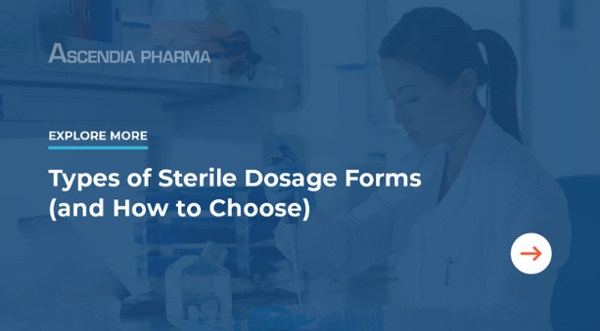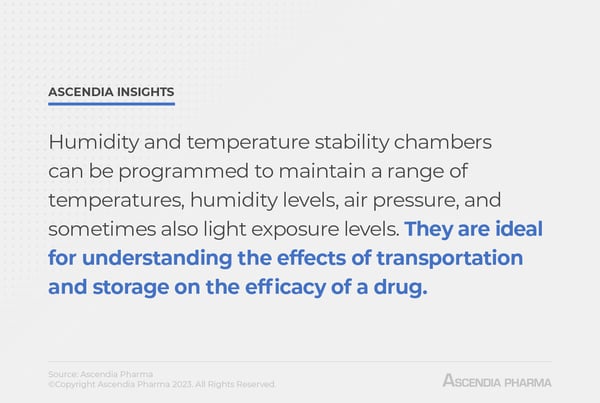Stability Chambers: Testing, Equipment & Uses
Testing is one of the most important stages of the development process for many pharmaceutical products. One of several methods used to ensure the quality of a product is to subject it to environmental testing in a stability chamber.
A stability chamber simulates different real-world conditions to help determine the effects of temperature, pressure, oxygen levels, light, and humidity on a product. The pharmaceutical industry uses these chambers to understand how their products will behave over time, ensuring that they are safe not only upon manufacture, but also after transport and storage.
Related Read - Drug Formulation Development: Quick Reference Guide
What Is a Stability Chamber?
Stability chambers are used extensively in the pharmaceutical industry for testing and evaluating the shelf life of drugs. Stability studies involve subjecting pharmaceutical products to controlled conditions such as temperature, humidity, and light exposure. The idea is to simulate the real-world conditions that drugs encounter so that pharmaceutical manufacturers can understand how the products will perform over time. In addition to ensuring product quality, stability testing is required for regulatory approval of drugs and other pharmaceutical products.

Stability chambers are highly specialized pieces of equipment that replicate the environmental conditions found in a variety of industry settings such as warehouses, pharmacies, and other points of sale. A drug cannot go to market until a pharmaceutical company (and the FDA and other regulatory bodies) are certain that it can be safely transported and stored — or have an understanding of the conditions in which it must be transported and stored (i.e., refrigeration).
Related Read - How to Scale Up Pharmaceutical Manufacturing
Types of Stability Chambers
Stability chambers come in a variety of sizes, shapes, and capabilities. We’ll discuss capabilities later in this article, but when it comes to design, there are two main types of stability testing chambers used in the pharmaceutical industry:
Reach-In Stability Chambers
Reach-in stability chambers are the most common type. They feature a front door or side-opening door, temperature control, humidity control, and light exposure control. These chambers are suitable for stability studies of samples stored in bulk or small containers such as vials, capsules, and tablets.
Related Read - Capsule Formulation Development: From Dosage Forms to Filling
Walk-In Stability Chambers
Walk-in stability chambers are available for large-scale studies and feature a much larger interior space than reach-in chambers. These stability chambers can accommodate larger samples, such as bulk pharmaceuticals and more sizable containers. Walk-in stability chambers also can be configured with a range of features such as multiple temperature zones, airlocks, and other specialized pharmaceutical testing and analysis.
Related Read - Analytical Testing Outsourcing Feature Highlights Ascendia Services
Stability Chamber Uses
Stability chambers are used extensively in the pharmaceutical industry to simulate real-world environmental conditions and test product performance over time. This is a critical step in the drug development and approval process.
In addition to pharmaceuticals, stability chambers can be used for testing cosmetics, food products, and even medical equipment. By subjecting these products to these controlled conditions, manufacturers can ensure they meet safety and quality standards before they are released into the market.
In the pharmaceutical industry, stability chambers are used for:
- Product development
- Quality assurance testing
- Purity testing
- Potency testing
- Consistency testing (i.e., the variability from one batch to the next)
- Accelerated aging studies
- Regulatory compliance testing
- Microbiological testing for liquid parenteral injection (sterility, preservative efficacy, microbial count)
- Integrity of packaging
- Light resistance
In addition to these uses, stability chambers can be used for research activities such as studying the effects of different active ingredients or excipients.
Related Read - Types of Sterile Dosage Forms (and How to Choose)

Why Stability Testing Is Important
Stability testing is an important part of the pharmaceutical development process, as it can help to ensure that a drug or other product meets its intended quality standards. Stability studies also provide valuable data on how drugs will perform over time and in different environmental conditions. This information is critical for compliance with regulatory requirements and for providing customers with safe and effective products.
Although stability testing is only one of many methods, it provides an efficient and reliable way to evaluate the shelf life of drugs and other products over time in a variety of real-world conditions. This testing gives manufacturers valuable data about drug performance; the resulting data can then be used to make informed decisions about product development, quality assurance protocols, ideal transportation, and storage conditions.
Related Read - Biologics vs. Small Molecule Drugs: Which Are Better?
How Does Stability Testing Work?
As noted, stability testing involves subjecting drug products to a variety of environments over time, so different types of stability chambers may be used for evaluating stability in hot or cold, humid conditions, and when exposed to light. Other times, a stability chamber may have multiple functions, allowing manufacturers to test all of these factors in one unit.
Samples are placed inside the stability chamber, and then they are monitored for changes in appearance, physical properties, chemical composition, and other factors. The results of these tests are used to determine the shelf life and efficacy of a drug; they are also key to understanding how drugs must be stored. Depending on the type of stability chamber used, these studies can take several weeks or even months to complete.
Once the stability testing is complete, stability test samples are evaluated by means of visual inspection, assay testing, degradation product analysis, microbial evaluation, dissolution rate determination, and moisture content measurement, among other methods.
By subjecting drugs to a number of conditions in a controlled environment, stability chambers provide manufacturers with data not only to ensure quality and compliance with regulatory bodies after a drug has been manufactured, but also as part of the drug development process. Stability chambers can also be used to test the effects of different active ingredients and excipients on drug efficacy, providing pharmaceutical companies guidance when formulating a drug.
Related Read - 4 Factors Affecting Solubility of Drugs
Humidity and Temperature Stability Chambers
Humidity and temperature stability chambers are used to simulate different environmental conditions for testing the shelf life of drugs. These chambers can be programmed to maintain a range of temperatures, humidity levels, air pressure, and sometimes also light exposure levels. This type of chamber is ideal for understanding the effects of transportation and storage on the efficacy of a drug.

Humidity chambers are typically designed to offer temperatures from 0ºC to 80ºC and relative humidity levels ranging between 20% to 90%. Some specialized options may extend this range. Interior components with corrosion-resistant capabilities are used due to the extended exposure of dampness. Energy efficient fans, compressors, and heaters are often incorporated into this stability testing equipment to help decrease costs while running for longer periods during product testing.
Related Read - Lyophilization Contract Manufacturing Services: What to Know
Accelerated Stability Chambers
Accelerated stability chambers are used for accelerated aging studies. This type of testing involves subjecting drugs to extreme environmental conditions such as high temperatures, humidity levels, and light exposure levels, allowing pharmaceutical companies to test long-term stability in a short-term time frame.
Related Read - Nano-Emulsion Formulation Overcomes Challenges
Photostability Chambers
Photostability chambers are used to measure the effects of light exposure on drug products. This type of testing involves exposing drugs to high levels of light for controlled periods of time, such as sunlight or artificial light sources. Photostability chambers are used to evaluate the shelf life and efficacy of drugs in different lighting conditions.
Photostability chambers have multiple fluorescent lamps that distribute light uniformly in visual or near ultraviolet ranges; they can be adjusted to reach different temperature levels, air ventilation rates, and humidity settings as needed. These stability chambers supply high-intensity lighting in the 300-700 nm range, which complies with ICH guidelines.
Related Read - GMP Requirements for Clinical Trial Material: An Overview
The Bottom Line: Go to Market Faster with Right Partner
Stability chambers are essential for ensuring product safety, quality and compliance with regulatory requirements. By testing the effects of various environmental factors on drug performance, these chambers provide manufacturers with critical data. As such, stability chambers are an invaluable tool in the pharmaceutical industry.
At Ascendia Pharma, we utilize the state-of-the-art ICH stability chambers and testing equipment at our pharmaceutical manufacturing facility in the USA to ensure your drugs get to market faster. To learn more about working with Ascendia, contact us today.

